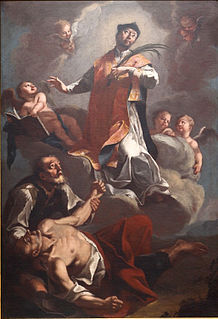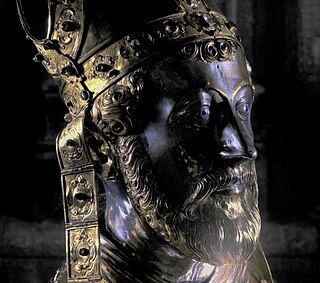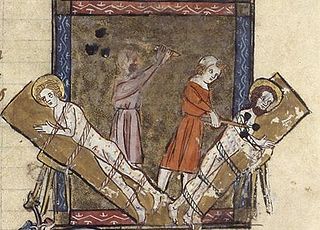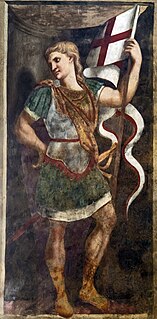Related Research Articles

Saint George, also George of Lydda, was a Christian who is venerated as a saint in Christianity. According to tradition he was a soldier in the Roman army. Saint George was a soldier of Cappadocian Greek origin and member of the Praetorian Guard for Roman emperor Diocletian, who was sentenced to death for refusing to recant his Christian faith. He became one of the most venerated saints and megalomartyrs in Christianity, and he has been especially venerated as a military saint since the Crusades.

Saint Valentine was a 3rd-century Roman saint, commemorated in Western Christianity on February 14 and in Eastern Orthodoxy on July 6. From the High Middle Ages his Saints' Day has been associated with a tradition of courtly love. He is also a patron saint of Terni, epilepsy and beekeepers.

Denis of Paris was a 3rd-century Christian martyr and saint. According to his hagiographies, he was bishop of Paris in the third century and, together with his companions Rusticus and Eleutherius, was martyred for his faith by decapitation. Some accounts placed this during Domitian's persecution and identified St Denis of Paris with the Areopagite who was converted by Paul the Apostle and who served as the first bishop of Athens. Assuming Denis's historicity, it is now considered more likely that he suffered under the persecution of the emperor Decius shortly after AD 250.

Saint Ursula is a legendary Romano-British Christian saint who died on 21 October 383. Her feast day in the pre-1970 General Roman Calendar is 21 October. There is little information about her and the anonymous group of holy virgins who accompanied and, on an uncertain date, were killed along with her at Cologne. They remain in the Roman Martyrology, although their commemoration does not appear in the simplified Calendarium Romanum Generale of the 1970 Missale Romanum.

Saint Pancras was a Roman citizen who converted to Christianity, and was beheaded for his faith at the age of fourteen, around the year 304. His name is Greek (Παγκράτιος) and means "the one that holds everything".

Saint Servatius was bishop of Tongeren —Latin: Atuatuca Tungrorum, the capital of the Tungri—. Servatius is patron saint of the city of Maastricht and the towns of Schijndel and Grimbergen. He is one of the Ice Saints. His feast day is May 13.

July 31 - Eastern Orthodox liturgical calendar - Aug. 2

Saints Gervasius and Protasius are venerated as Christian martyrs, probably of the 2nd century. They are the patron saints of Milan and of haymakers and are invoked for the discovery of thieves. Their feast day in the Latin Rite of the Catholic Church is 19 June, the day marking the translation of their relics. In the Eastern Orthodox Church and in the Eastern Rites of the Catholic Church, their feast takes place on 14 October (O.S.)/24 October (N.S.), the traditional day of their death. In Christian iconography their emblems are the scourge, the club and the sword.
Alban of Mainz was a Catholic priest, missionary, and martyr in the Late Roman Empire. He is venerated as Saint Alban of Mainz in the Catholic Church, not to be confused with Saint Alban of Verulamium.

The designation Four Crowned Martyrs or Four Holy Crowned Ones refers to nine individuals venerated as martyrs and saints in Early Christianity. The nine saints are divided into two groups:
- Severus, Severian(us), Carpophorus (Carpoforus), Victorinus
- Claudius, Castorius, Symphorian (Simpronian), Nicostratus, and Simplicius

Saint Liberalis of Treviso is a saint of the 4th century. Tradition states that he was a priest who opposed Arianism and that he was persecuted at Ancona.

Saints Nereus and Achilleus are two Roman martyr saints. In the present General Roman Calendar, revised in 1969, Saints Nereus and Achilleus (together) are celebrated on the 12th of May.
Saints Felinus and Gratian(us) are venerated as martyrs by the Catholic and Eastern Orthodox churches. They are patron saints of Arona, near Milan, where their relics were enshrined.

Quirinus is venerated as an early bishop of Sescia, now Sisak in Croatia. He is mentioned by Eusebius of Caesarea.
Saint Theonistus is a saint venerated by the Catholic Church. Theonistus is venerated with two companions, Tabra and Tabratha. Medieval documents give accounts of his life, which are contradictory and confused.
The anonymous pilgrim of Piacenza, sometimes simply called the Piacenza Pilgrim, was a sixth-century Christian pilgrim from Piacenza in northern Italy who travelled to the Holy Land at the height of Byzantine rule in the 570s and wrote a narrative of his pilgrimage. This anonymous pilgrim was erroneously identified as Antoninus of Piacenza or Antoninus Martyr out of confusion with Saint Antoninus of Piacenza, who died in 303 and is venerated as a martyr.

Eleutherius (or Eleut erus or Eleftherios; sometimes called Liberalis or Liberator, the former transliterations and the latter translations of his and his mother Antia are venerated as Christian saints and martyrs in Albania.

Saint Aurea of Ostia is venerated as the patron saint of Ostia. According to one scholar, “[a]lthough the acta of Saint Aurea are pious fiction, she was a genuine martyr with a very early cultus at Ostia.”

Vercelli Cathedral is the principal church of the city of Vercelli in Piedmont, Italy, and the cathedral of the Archdiocese of Vercelli. It is dedicated to Saint Eusebius of Vercelli, the first bishop.

The Catacombs of San Sebastiano are a hypogeum cemetery in Rome (Italy), rising along Via Appia Antica, in the Ardeatino Quarter. They are one of the very few Christian burial places that have always been accessible. The first of the former four floors is now almost completely destroyed.